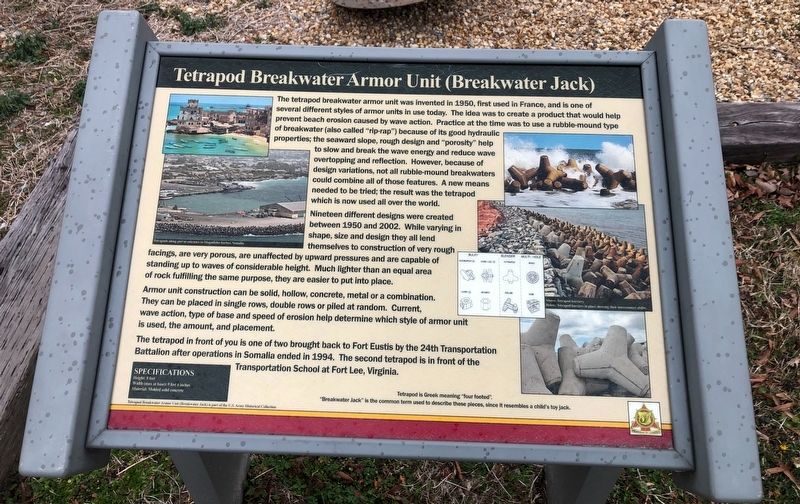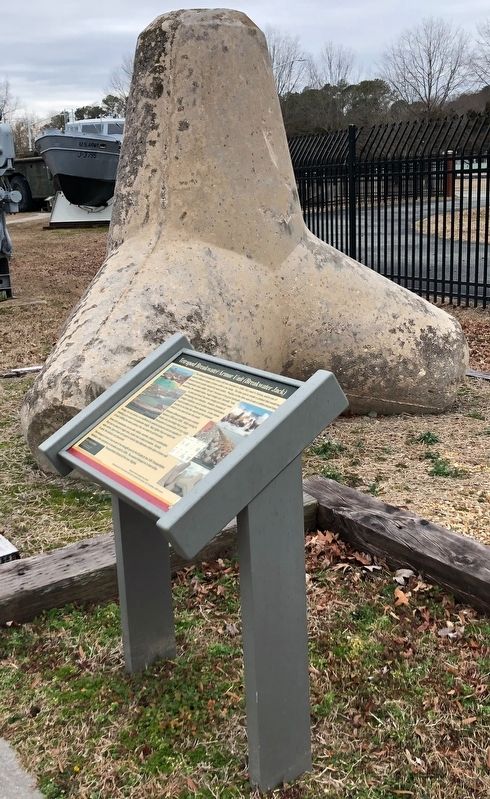Tetrapod Breakwater Armor Unit (Breakwater Jack)

The tetrapod breakwater unit was invented in 1950, first used in France, and is one of several different styles of armor units in use today. The idea was to create a product that would help prevent beach erosion caused by wave action. Practice at the time was to use a rubble-mound type of breakwater (also called "rip-rap") because of its good hydraulic properties; the seaward slope, rough design and "porosity" help to slow and break the wave energy and reduce wave overtopping and reflection. However, because of design variations, not all rubble-mound breakwaters could combine all of those features. A new means needed to be tried; the result was the tetrapod which is now used all over the world.
Nineteen different designs were created between 1950 and 2002. While varying in shape, size and design they all lend themselves to construction of very rough facings, are very porous, are unaffected by upward pressures and are capable of standing up to waves of considerable height. Much lighter than an equal area of rock fulfilling the same purpose, they are easier to put into place.
Armor unit construction can be solid, hollow, concrete, metal or a combination. They can be placed in single rows, double rows or piled at random. Current, wave action, type of base and speed of erosion help determine which style of armor unit is
used, the amount, and placement.
The tetrapod in front of you is one of two brought back to Fort Eustis by the 24th Transportation Battalion after operations in Somalia ended in 1994. The second tetrapod is in front of the Transportation School at Fort Lee, Virginia.
Erected by US Army Transportation Museum.
Topics. This historical marker is listed in these topic lists: Wars, Non-US • Waterways & Vessels. A significant historical year for this entry is 1950.
Location. 37° 9.899′ N, 76° 34.55′ W. Marker is in Newport News, Virginia. It is in Fort Eustis. Marker can be reached from Washington Boulevard, 0.1 miles north of Jefferson Avenue, on the right when traveling north. Touch for map. Marker is at or near this postal address: 321 Washington Blvd, Fort Eustis VA 23604, United States of America. Touch for directions.
Other nearby markers. At least 8 other markers are within walking distance of this marker. Marine Diesel Engine DMG 6, Training Aid (here, next to this marker); Lighter, Amphibious Resupply, Cargo, 'LARC V' 5X (here, next to this marker); FS Anchors - Freight Supply (FS) Ships (here, next to this marker); Maritime Operations in the Transportation Corps (a few steps from this marker); Vertical Axis Propeller - Beach Discharge Lighter 'BDL' 1x (a few steps from this marker); Lighter, Amphibious Resupply, Cargo, 'LARC XV'

Credits. This page was last revised on February 1, 2023. It was originally submitted on February 28, 2021, by Devry Becker Jones of Washington, District of Columbia. This page has been viewed 205 times since then and 31 times this year. Photos: 1, 2. submitted on February 28, 2021, by Devry Becker Jones of Washington, District of Columbia.